|
Getting your Trinity Audio player ready...
|
Established in 1919
Gazing from the canyon’s edge, behold a vast landscape shaped by nature. Jagged peaks and weathered rocks seem to stretch forever, making this one of Earth’s most breathtaking sights.
Even if you haven’t seen the Grand Canyon, you probably know that it’s really only describable as being indescribable. But it’s our job to try, so what the heck. The Grand Canyon is a cavernous amphitheater spanning eighteen miles across, a yawning pit carved into a flat mesa by one of the great rivers of the United States. Layered with bands of stone and crosscut by twisting side canyons, it is truly an awe-inspiring sight. It’s one of the Seven Natural Wonders of The World and has a place on anybody’s bucket list. But for most visitors, that’s all it is. Something to drive to, to look at, to take pictures of.
What you may not have realized is that it is also a vast expanse of wilderness which is surprisingly not completely inaccessible. That is, if you have the skills and the equipment to venture in. The Grand Canyon was once the last blank spot on the map of America, and to this day it remains one of the most rugged, pristine, and sometimes even treacherous landscapes in the country. It’s secrets: oases, slot canyons, waterfalls, and wildlife all beckon to the would-be intrepid explorer daring enough to go forth. Does that sound like you?
If yes, then this guide is for you. If no, then maybe we can convince you otherwise. We put together this guide to Grand Canyon National Park to give you all the essential information you need to visit and enjoy the park and everything it holds. You never know, this guide might be the inspiration for your next adventure.
Looking For An Amazing Adventure? Book A Hiking Tour in Grand Canyon National Park
Human History
Though its harsh exterior may suggest that it is inhabitable, humans have been living in and around the Grand Canyon since around 12,000 years ago. Our understanding of the Grand Canyon’s native inhabitants draws from the things they left behind. The interior of the Grand Canyon holds a wealth of archaeological artifacts. In a survey of just 5% of the park’s total area, 4,300 archaeological sites were found. This gives us the impression that ancient peoples were not only surviving, but thriving here. These ancient peoples are the ancestors of the 11 distinct cultures of modern native peoples that are associated with the Grand Canyon.
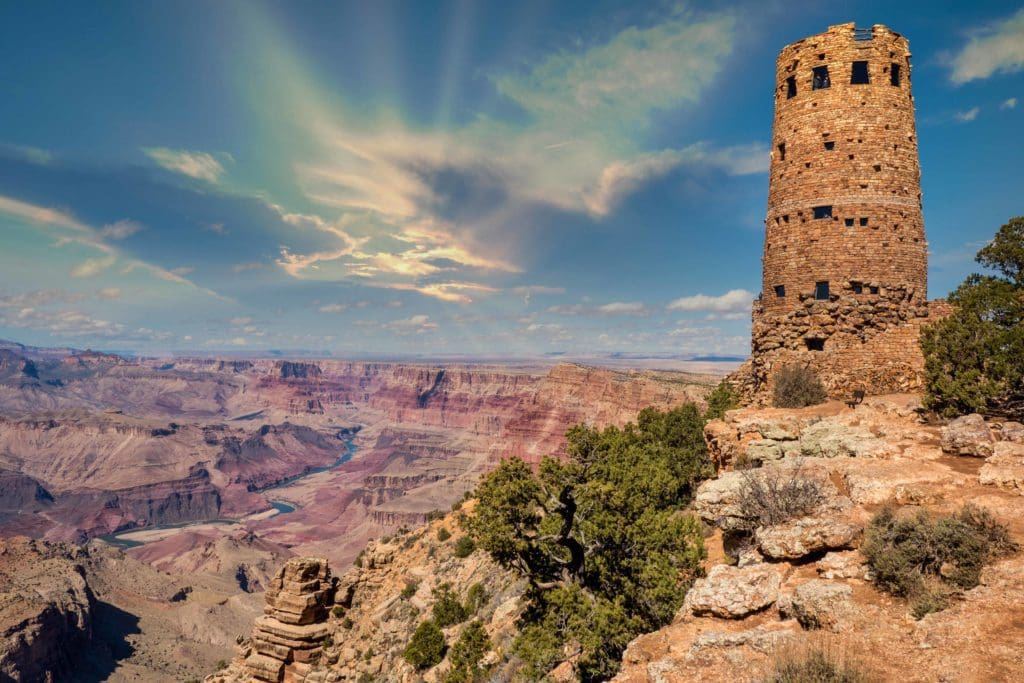
Desert View Watchtower at the South Rim of the Grand Canyon National Park.
Through the archaeological record, we know that prehistoric peoples gathered around perennial water sources, but most likely were at least semi-nomadic. They worked stone into sharp points and hunted game with atlatls. As time progressed, culture and technology developed. We begin to find basketry, pottery, and evidence of early horticulture. People began to become more and more sedentary, and the first pueblo-style buildings appeared in rock outcroppings. You can visit some of the ruins of Ancestral Puebloan peoples in the Grand Canyon, like the Tusayan Pueblo. Of the artifacts left behind by ancient native peoples, maybe the most interesting are the split-twig figurines, which may have had spiritual significance, or may have simply been toys for children.
So to say that the Grand Canyon was ever “discovered” is a loaded statement. But the first European eyes to ever fall on the Grand Canyon were those of Spanish explorers, led by García López de Cárdenas, around 1540. Try as they might, Cardenas and his men were unable to get below the upper rim of the canyon. And for another 350 years after Cardenas left, the area would remain unexplored.
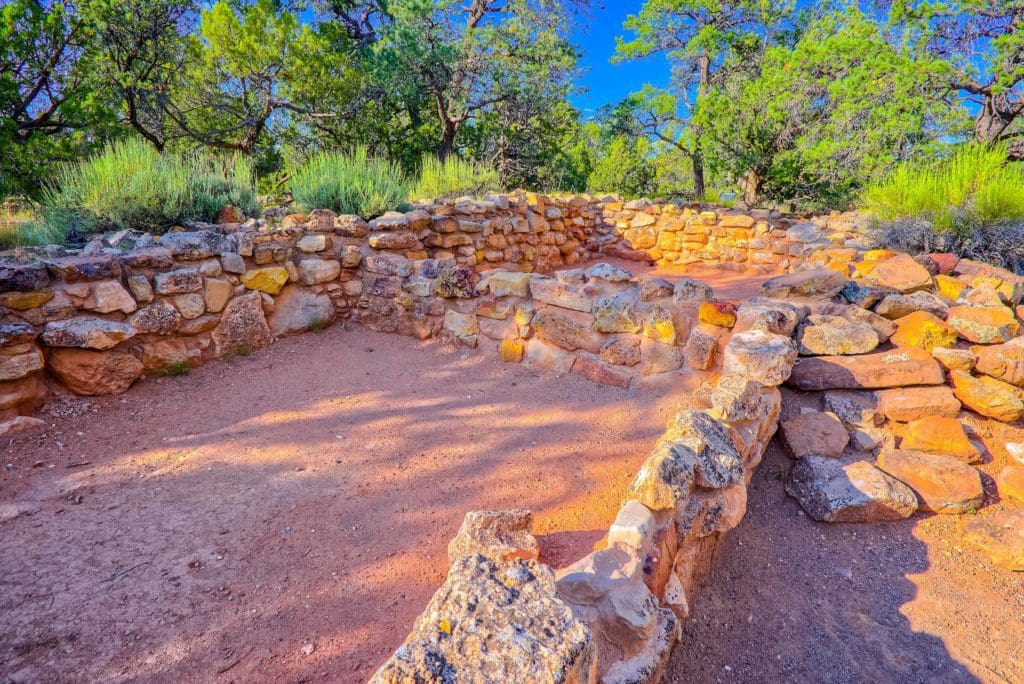
The Tusayan Ruins at the Grand Canyon National Park. The ruins are from the Pueblo Indians and is around 800 years old.
The first European to reach the river was Joseph Christmas Ives. Using a 50-foot-long steamboat, Ives was able to navigate one of the side canyons to the Colorado. This is an almost absurd undertaking by today’s standards, considering that the Grand Canyon holds some of the most dangerous, technical whitewater in the United States.
But this fact wouldn’t deter others from attempting to float the Grand Canyon. Bolstered by Ives’ reports of the canyon, Major John W. Powell embarked on his own expedition. Funded by the US Geological Survey, he set out from Green River, Wyoming to navigate the Green River to the Grand Canyon. Up to this point, this stretch of land represented the last blank spot on the map of the United States. Despite having only one hand (due to an injury sustained in the Civil War), and using the modern-day equivalent of wooden rowboats, Major Powell’s party succeeded in penetrating and floating the Grand Canyon.
Powell would later return on a second expedition to explore many of the side-canyons and tributaries of the Colorado, resulting in the discovery of many areas that would later become National Parks. His exploits are covered at length in writing in The Exploration of the Colorado River and its Canyons, a must-read for anyone with an enthusiasm for canyon country. The successful exploration of the area drove miners and entrepreneurs to survey the canyon in more depth, attempting to find and harvest natural resources.
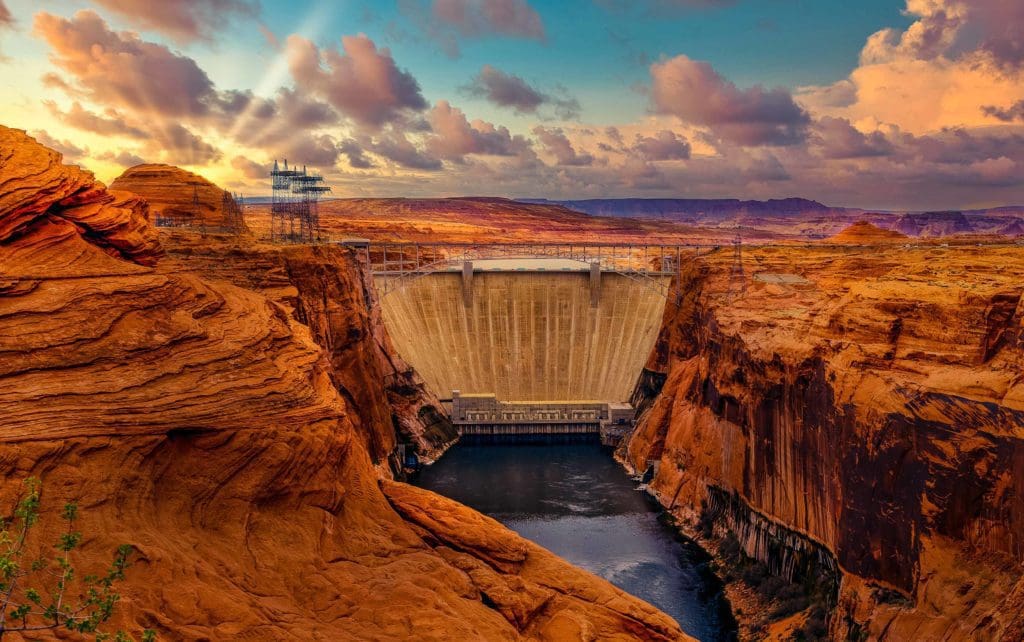
Glen Canyon National Recreation area encompasses Lake Powell and lower Cataract Canyon in Utah and Arizona.
In 1903, the canyon was visited by Theodore Roosevelt, who lauded its magnificence and natural beauty. But it would be another 16 years before the park was enacted in 1919 by President Wilson. In terms of conservation, this act is considered a major victory. It prevented the river from being dammed within the boundaries of the park, although upriver the Glen Canyon Dam would be constructed in the 1950s. Furthermore, it served as a shining example of the ideal of public land: preserving natural places that human influence would inevitably mar.
Adventure Talk: Epic Rim to Rim Grand Canyon Backpacking Tour
Geology
In a general sense, the formation of the Grand Canyon began two billion years ago with the surfacing of igneous rock found in the inner gorge. The deposition the minerals found in the upper layers of the canyon would come much later, during the Laramide Orogeny, a period of uplift which created the Colorado Plateau. Around five to six million years ago, the creation of the canyon itself began with the weathering and erosive force of the Colorado River, which stretches 1,450 miles from the Rockies to Northern Mexico.
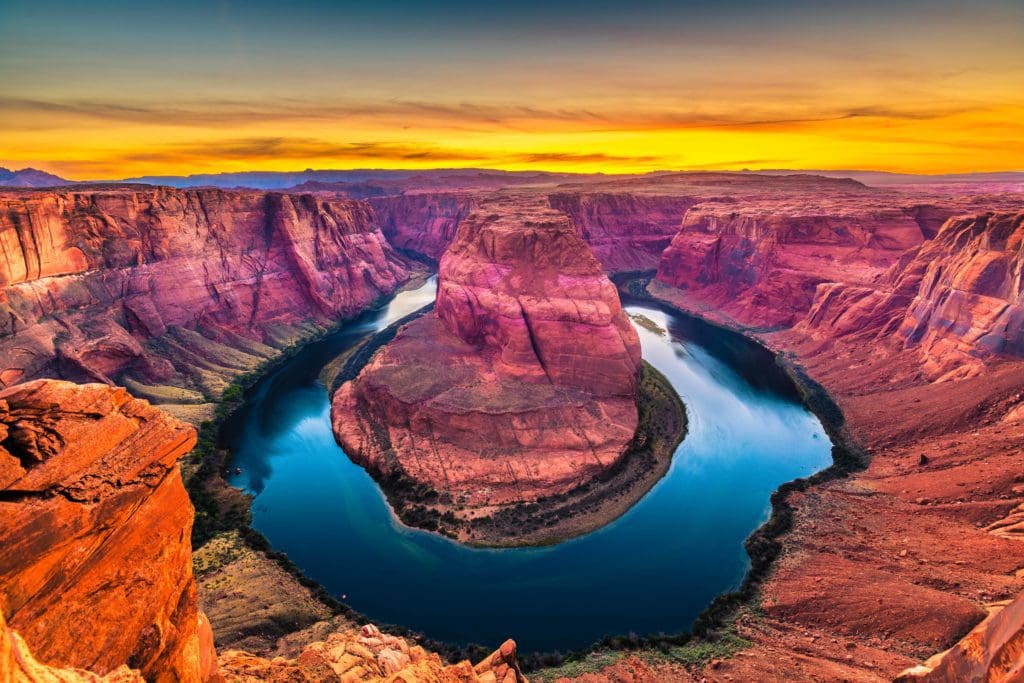
Horseshoe Bend on the Colorado River at sunset near Page, Arizona.
The watershed of the Colorado River encompasses 246,000 square miles and, historically, drained 16.3 million acre-feet per year of water into the Gulf of California, though the river no longer reaches the ocean. Along its transit, this water has historically carried 85-100 million tons of sediment to the ocean each year, wearing away the stark cliff sides of the Colorado Plateau and deepening channels in the rock. The action of this never-ending torrent has resulted in some of the most dramatic canyons on Earth. Without question, the largest and most impressive of these is the Grand Canyon. It stretches a staggering 277 miles, is 18 miles wide at its widest, and up to 6,000 feet deep. Without question, it’s one of the largest canyons on Earth.
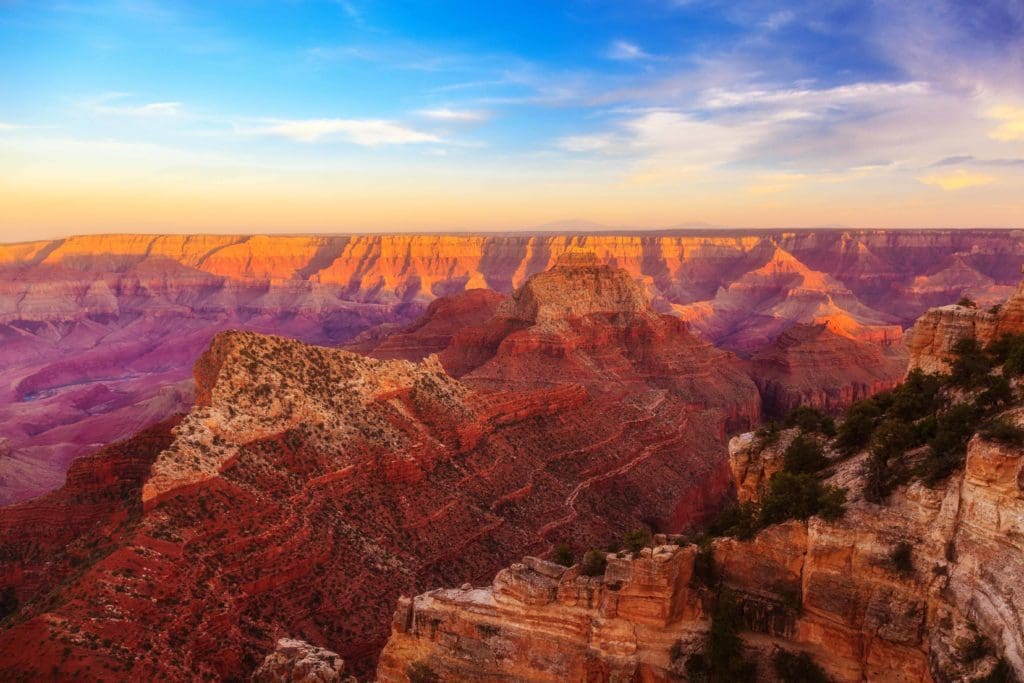
You can see geological layers of time represented in bands of rock in the Grand Canyon.
Looking into the canyon, you can see geological layers of time represented in bands of rock. These are the oldest layers in the Grand Staircase, a massive, unique geological formation which stretches from the Grand Canyon all the way to Bryce Canyon in Utah. Among these bands of stone you can find limestone, shale, sandstone, and volcanic rock. This swath of strata reads like a history book, showcasing the development of the canyon in chronological order from bottom to top. With each passing year, weathering and erosion deepen and widen the canyon, revealing more of this tapestry that is still being made.
Ecology
Saying that the Grand Canyon is a desert does not even come close to covering all of the complexity found in the park. Covering 6,000 feet of elevation across a spiderwebbing network of side-channels and mountaintops, the Grand Canyon contains a variety of different ecosystems. These are primarily defined by their elevation, how much water is present, and how much sun or shade there is. These subtle differences can allow completely different communities of plants to crop up, and in turn, different communities of animals.
Of these, riparian ecosystems are the wettest and often the lowest, though they can occur at higher elevations. Riparian ecosystems occur along the edges of permanent water sources (especially the Colorado River itself) and feature broadleaf shrubs and trees like willows and cottonwoods. In the Grand Canyon, you may see canyon tree frogs, tiger salamanders, kingfishers, great blue herons, and small mammals in riparian areas. In the evening, be on the lookout for bats above still water. The Grand Canyon is home to sizable populations of spotted bats, cliff dwelling species which are specialized to hunt large moths.
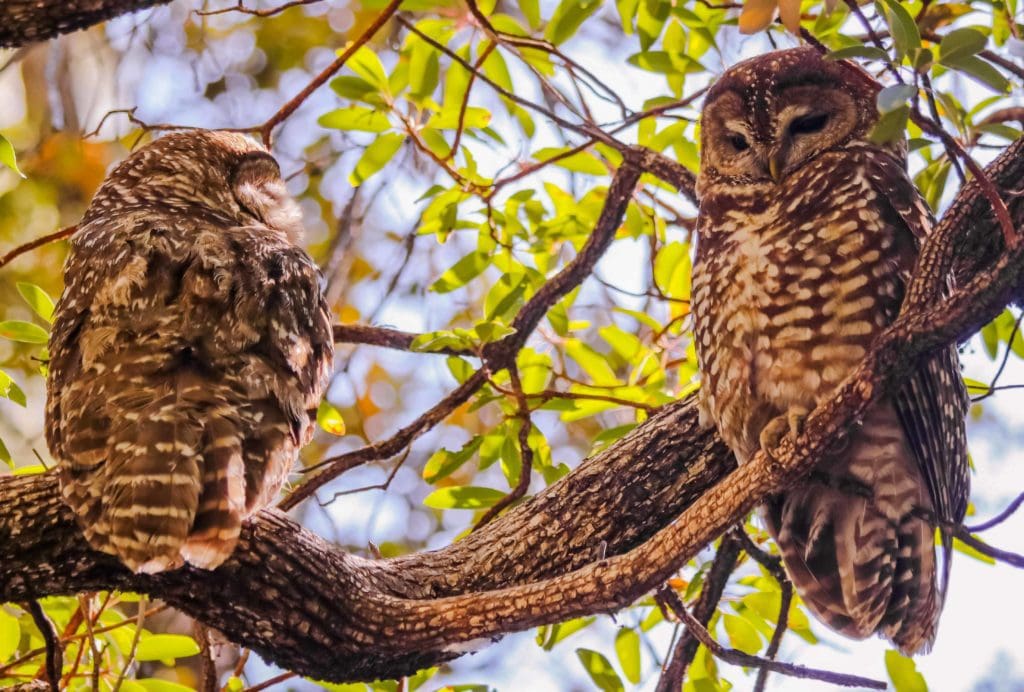
A Breeding Pair of Mexican Spotted Owls in Their Roost.
Further from water you’ll likely find dry scrubland ecosystems, the hottest and driest parts of the park. Reptiles like gila monsters, short-horned lizards, rattlesnakes, scorpions, and Mexican spotted owls are common here. Plants can be more typical of the Sonoran Desert or the Great Basin, depending on the part of the park you’re in. The hot and dry cliff walls of the canyon are also home to certain animals like the elusive and charismatic bighorn sheep.
Gaining elevation we begin to see pinyon-juniper woodlands. These trees may look familiar to anyone who has visited the Colorado Plateau – with twisted and cracked trunks emerging from split rocks and thriving in intense heat. But they provide shade for animals like ringtails, deer, and raptors like the loggerhead shrike, the smallest bird of prey in the US.
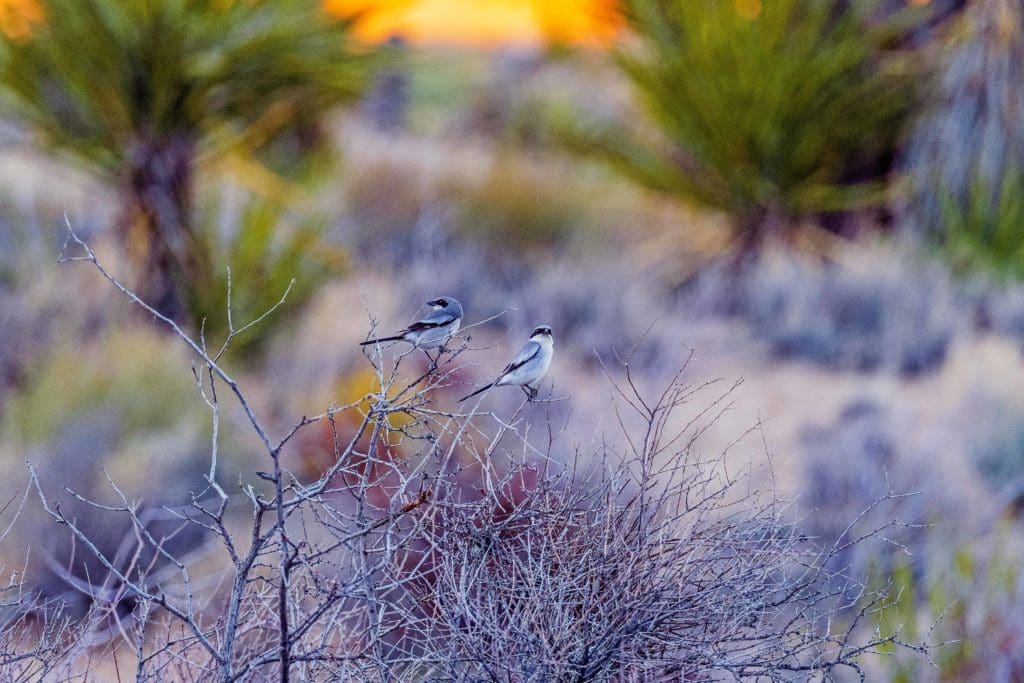
A Pair of Loggerhead Shrikes Enjoying the Desert Sunset.
Higher still we find dry pine forests dominated by ponderosa pine. The ponderosa is specially designed with thick bark to resist wildfire. With sturdier trees comes habitat for even more animals. Woodpeckers, squirrels, skunks, and animals more typically thought of in mountain ecosystems begin to become prevalent.
At the top of the mighty layer cake that is the Grand Canyon we find mixed conifer forests. These may include mountain species like lodgepole pine, douglas fir, and subalpine fir. Looking around in a mixed conifer forest, you may think you were in the mountains of Wyoming. Large mammals like bison and elk thrive here, especially on the North Rim. You may see birds like the zone-tailed hawk or California condor soaring high above the canyon’s depths.
These five zones work in harmony with one another, even though they stand in contrast. The closer you look, the more you will realize that the different parts of the Grand Canyon are not separate. They grow and change together, sharing resources and using different aspects of the canyon’s structure to survive.
Main Attractions
Planning a short visit to the Grand Canyon can be as simple as answering one question: which rim do you want to see? The canyon is so broad that seeing each rim requires entering from a different state. For most visitors this is a no-brainer. The South Rim has far more infrastructure, better roads, more trailheads, and more options for lodging. These are all smart reasons to choose the South Rim. However, if the idea of driving through the vast desert into mountainous terrain, seeing unique wildlife, and having miles and miles of canyon skyline to yourself sounds like your kind of adventure, you should consider visiting the North Rim.
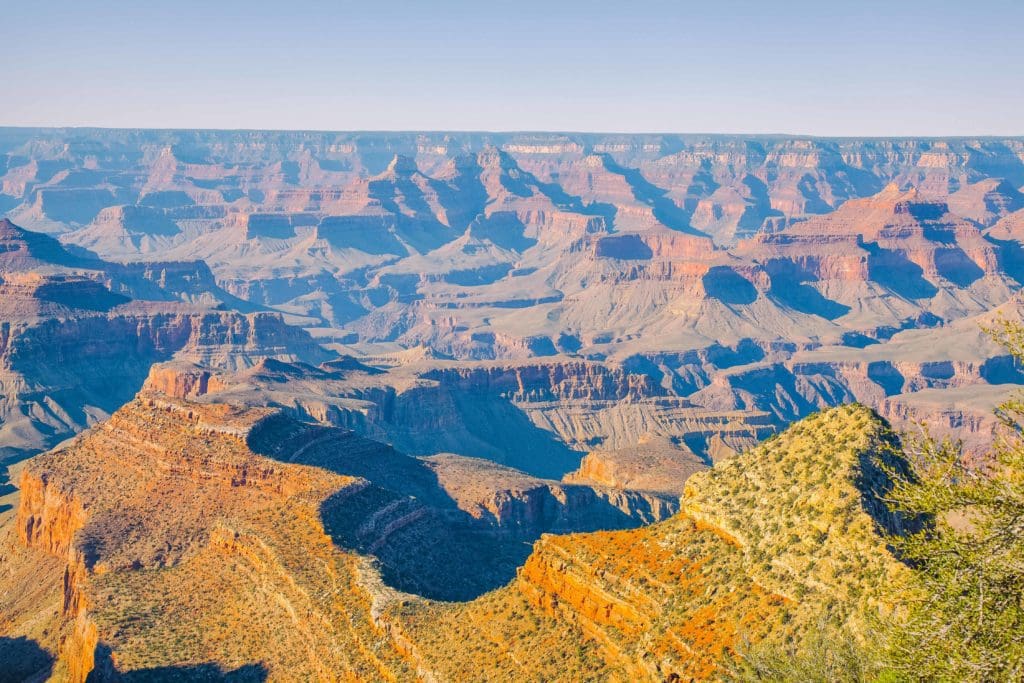
View of the colors of the Grand Canyon from Grandview Point Lookout.
If you do choose to visit the South Rim, there are a few must-see spots to stop and view the canyon. Some of these are restricted to shuttles, so plan ahead. If you take Desert View Drive into the park, you will conveniently pass Grandview Point, a fantastic panorama of the canyon. Moving west, you’ll come to the Grand Canyon Village. Here there are hotels, gas stations, and a market to stock up on groceries. The Village is full of attractions and has quite a view, as well as access to the Rim Trail. Continuing further west you can board a shuttle to Hermit’s Rest Road. Hermit’s Rest ends at a stunning panorama, complete with an old timey rest stop where you can grab an ice cream cone to beat the heat.
Surviving the Desert
Beyond this point, all visitors should be advised of the basic dangers of traveling on foot in the high desert. The park employs entire teams of search and rescue crews to extract would-be adventurers from mishaps in the backcountry. The vast majority of these are caused by a lack of preparedness. Bringing too little water, having poor navigation skills, and negotiating technical terrain without the necessary know-how and gear are potentially deadly mistakes here.
Even on short hikes, high temperatures and exposure add an element of risk that cannot be taken lightly. Heat exhaustion and dehydration can lead to deliriousness, which increases your odds of falling into the canyon by whole orders of magnitude. If you plan to venture below the rim, be advised that there is no “easy” route. Put plainly, the Grand Canyon is not friendly to inexperienced hikers. Remember that this country was the last unexplored corner of the United States, and for good reason.
If you do venture out, do the necessary research beforehand. Consider water, either how much you need to bring or how much access to water you will have on the trail. While packing, ensure you have the ten essentials. Your primary goal in setting out below the rim should be avoiding accidents. Know your route, know the conditions, know your body. The hardest part of any hike in the Grand Canyon is the way back, so while on the trail, be sure to save a little gas for later. Before you go, be sure to consult the park’s hiking tips page, and as always, the Leave No Trace Code of Ethics.
Camping
What could possibly be better than lying out under the stars on the rim of one of the most spectacular canyons on Earth? Luckily there are plenty of options for roughing it in Grand Canyon National Park.
On the South Rim, you can primitive camp at either Mather or Desert View Campground. There is an additional RV park at the Grand Canyon Village with full hookups. Mather and Desert View are on either side of Grand Canyon Village, separated by miles of canyon rim. Mather has 327 sites in total, whereas Desert View has only 49. Either way, plan your stay well in advance. Reservations at Mather are accepted from March first through November 30th, and April 29th through October 16th at Desert View. Outside of the park, you can practice “dispersed camping” on Kaibab National Forest. Just be sure to follow proper practices for dispersed camping, for example, don’t create any new fire rings when pitching camp.
If you plan to camp on the North Rim, your main option is North Rim Campground, which sits at 8,200 feet. North Rim Campground is open May 30th – October 11th, and is reservation only. There are 87 sites in total, situated on a precipice overlooking the canyon. These are some of the grandest accommodations in the canyon, with amazing views and access to major trailheads.
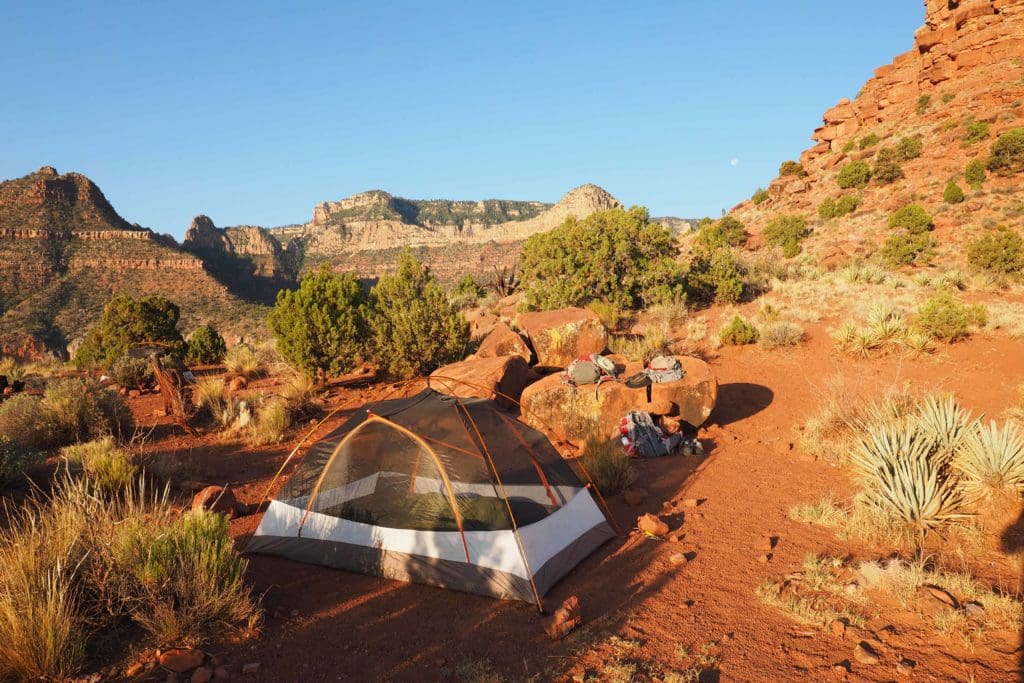
Tent camp on Horseshoe Mesa in early morning light in Grand Canyon National Park, Arizona.
Hiking
For most visitors, hiking is the main recreational draw to the Grand Canyon. There are tons of options for seeing the canyon on foot. But (as mentioned above), you should be aware that there are no trails considered “easy” here. Routes are exposed, conditions are hot, and the way back is always harder than the way you came. That said, if you prepare yourself and dare to explore below the rim, there are natural treasures to be found everywhere.
Probably the most accessible option in the park is Bright Angel Trail. The trail follows a drainage down into the canyon, providing some shade (depending on the time of day) and passes several landmarks, including Indian Garden, a natural oasis with water available. You can go up to six miles out to Plateau Point, making for a round trip total of 12 miles.
For a shorter option with good water access, you could also go for the Hermit Trail to Santa Maria Spring, a five mile round trip with several springs along the way. If you want to maximize the scenic views, the South Kaibab Trail is a must. It follows a ridgeline (meaning there is no water available) and can be taken as far as Skeleton Point as a day hike.
If you’re hungry for high points, check out The Battleship. This adventure is not for the faint of heart, clocking in at nine miles round trip, including a lot of scrambling. From the summit you’ll have unbelievable views in a full 360 degree panorama.
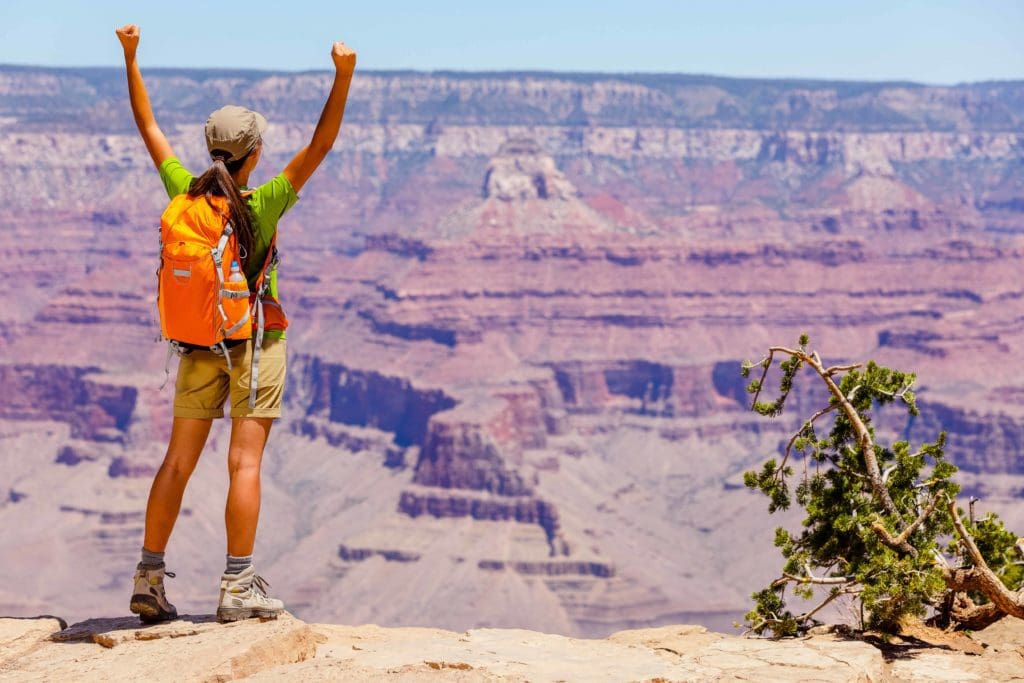
Grand Canyon hiking.
Backpacking
Backpacking in the Grand Canyon is a once-in-a-lifetime opportunity. If you want to truly immerse yourself in a desert wilderness, there’s no better way. Be aware, this isn’t the kind of trip you can set out on spontaneously. There is some red tape involved and a lot of preparation and planning that needs to be done before you can go. Consideration for permits generally begins around six months before your planned start date.
But the permitting process is well worth the preparation and time. There are 32 backcountry campgrounds or camping areas throughout the park, which is divided into four “zones”. These zones exist to help backpackers choose a trail based on their level of experience and familiarity with the terrain. Newcomers are advised to plan trips in the Corridor Zone. This zone is centered around the Bright Angel, South Kaibab, and North Kaibab trails, which provide access to the river and the North Rim of the canyon. If you choose, you could even backpack from one rim of the canyon to the other, taking either Bright Angel or South Kaibab to the river, crossing one of two suspension bridges over the river, and exiting up the North Kaibab Trail.
Beyond this, the possibilities are limitless. There is a vast network of trails in the Grand Canyon National Park backcountry. But like with most big adventures, it’s best to start small. If you’re an experienced backpacker who has already ventured into the Corridor Zone, we recommend doing some research on trails in the Threshold Zone and contacting the park with your idea for a backcountry trip.
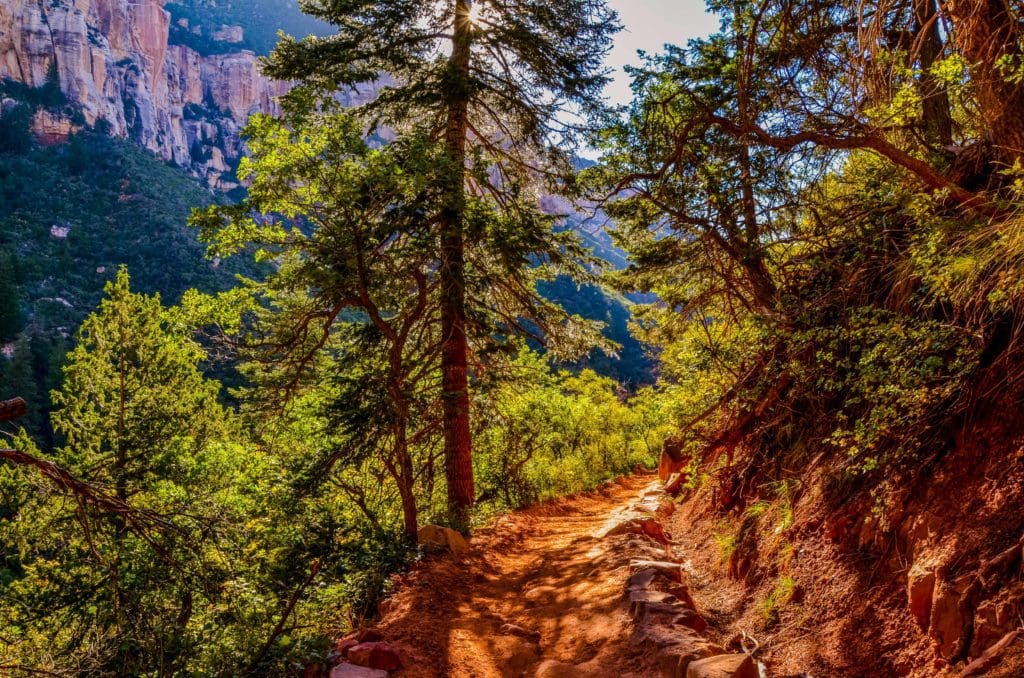
The beautiful ponderosa pine forest on the slopes of Roaring Springs Canyon on the North Kaibab trail at the North Rim in Grand Canyon National Park.
Pack Mule Trips
That’s right, pack mule trips. Because who wants to carry all that gear and water around when it’s 108 degrees below the canyon rim? Adding livestock to your trip can seriously reduce the effort of experiencing the Grand Canyon backcountry, as well as making it possible for less-fit folks to get out into it. Trips involving livestock are offered by private guides which contract with the NPS. Reservations for pack mule trips are given by a lottery. Read up on the park’s website for more information and regulations on pack mule trips through the Grand Canyon.
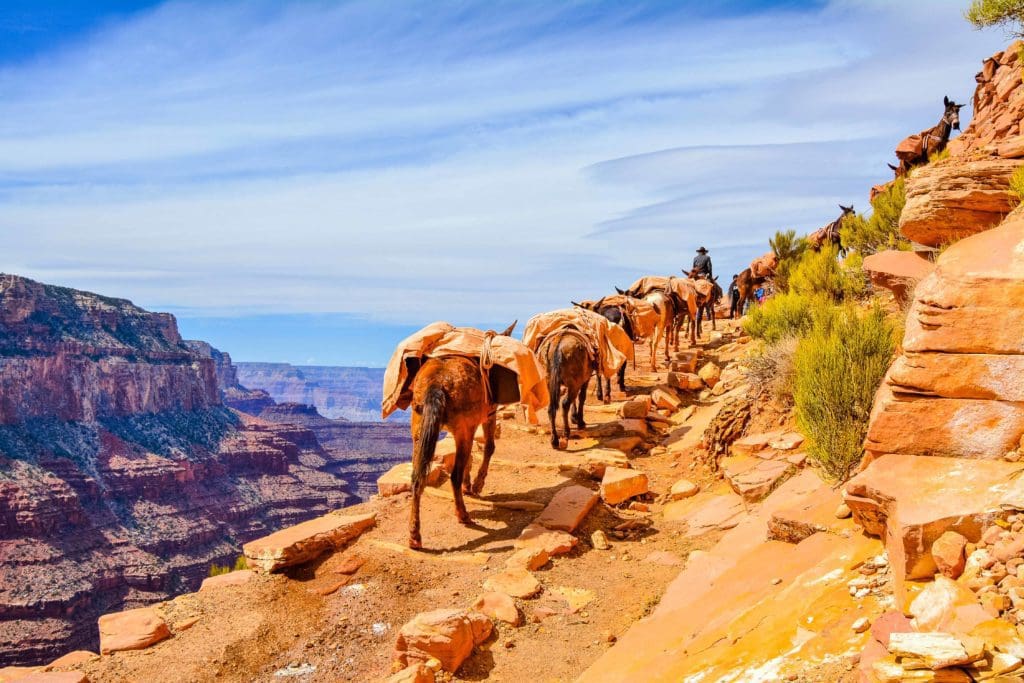
Mule pack train climbs from the bottom of the Grand Canyon on the South Kaibab trail.
Canyoneering
It should be no major surprise that the largest canyon in the United States is chock full of amazing canyoneering adventures. But be advised, more than almost any other endeavor you could undertake here, canyoneering is incredibly dangerous. Reading about these adventures and buying the necessary equipment accounts for almost none of the knowledge and experience needed to live to tell the tale. Get the proper training, know before you go, plan obsessively, and follow all backcountry guidelines and ethics while in the park.
That said, if you’re an experienced canyoneer looking to step it up a notch, the Grand Canyon has tons of great routes. Particularly in the 2BV-3BVI range, meaning some technical equipment, perennial water, and lots of time required. For all the trips listed here, overnighting is recommended. These are long, sporty canyon routes with lots of rappels. But they will take you to parts of the Grand Canyon you would never see otherwise.
A good starter for canyoneers new to Grand Canyon National Park is Big Canyon, rated 3BIV with four to five rappels, normally done in one or two days. Even more techy is Garden Creek Canyon, rated 3BIV with six or seven rappels, the longest of which is 200 feet. Several of these descend waterfalls. And if you don’t feel like lugging a massive static rope with you, you can check out Grapevine Canyon, a spicy, though non-technical route that will take two to five days to complete. It’s rated 2BVI, and includes sections of wading or swimming. Just what the doctor ordered on an August day in the hundred-and-tens.
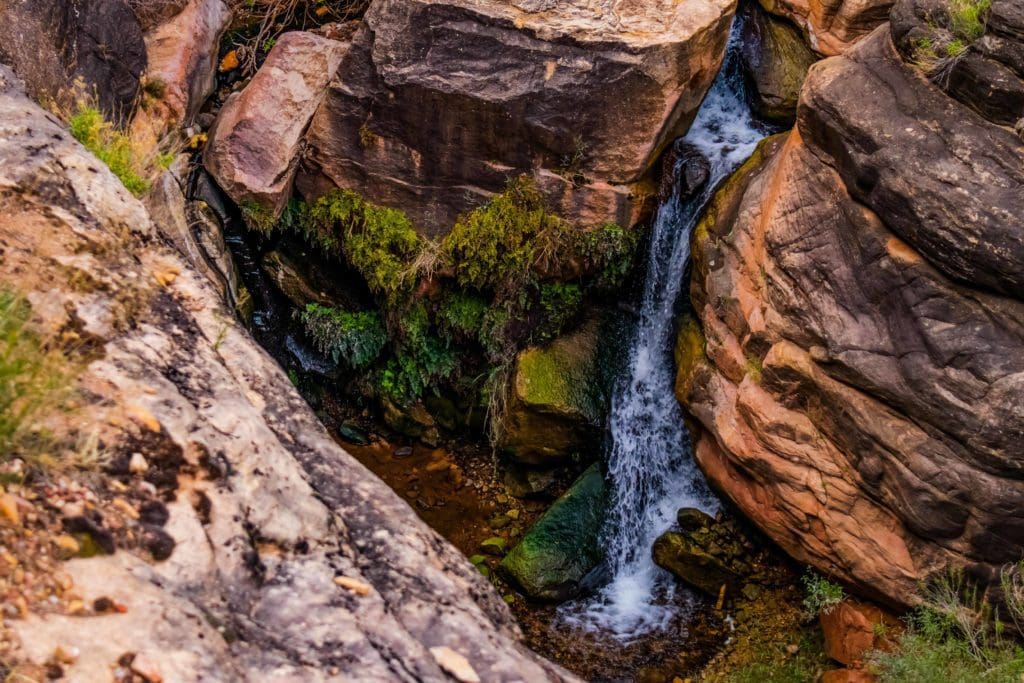
Garden Creek Falls at Grand Canyon National Park.
Rafting
If you haven’t noticed already, the Grand Canyon is considered the big leagues for most adventure sports. This is especially true of whitewater rafting. Rafting the Grand Canyon is probably the most epic river adventure you can undertake in the United States, if not the world. The Grand Canyon features one of the steepest elevation gradients on the Colorado River, meaning lots of big water. But that’s not the half of it. You’ll experience the heart of some of the wildest and most pristine country in the American West. Outstanding camping, wonderful views, and more than enough time to take it all in. Watching the sun set over soaring canyon walls, listening to the lazy lapping of the river on its banks, a cold beer and a hot dinner is about as close to paradise as some of us will ever get.
But to begin, there is a mountain of red tape to get through. If you plan to embark on a two to five day noncommercial river trip, you need to apply for a permit a year in advance to be considered. Longer trips (12 to 25 days) are awarded in a weighted lottery. The rules are slightly different for commercial trips. If you’re hiring a commercial guide, you don’t need to worry about permitting, just making reservations. This can still take some organization though. For long trips (three to 18 days), guides normally reserve one to two years in advance. For more information, check out the park website here.
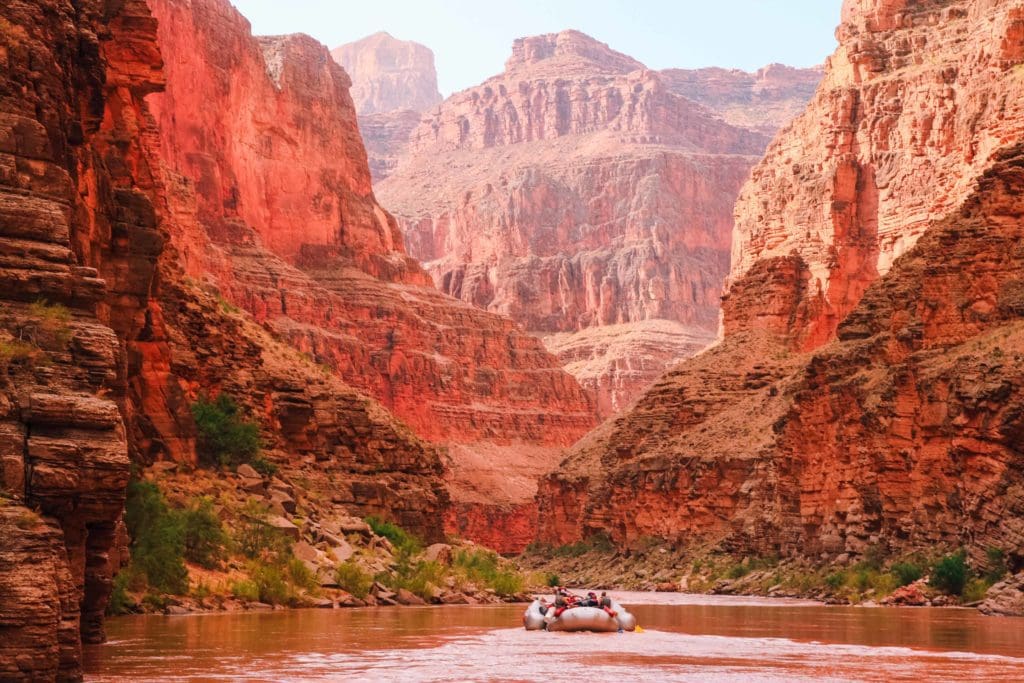
Grand Canyon White Water Rafting.
“You cannot improve on it.”
Maybe Roosevelt said it best himself. The Grand Canyon is absolutely perfect as it is. Getting to explore it, to witness firsthand how vast it is, is truly a magical experience. It’s a thing that demands respect, as well as your full attention. Maybe now you’re a little better prepared for your coming adventure. But believe us when we say that you’ll still be astounded when you see it firsthand.
When a travel emergency arises, traditional travel insurance may not come to your aid, and a medical evacuation can cost up to $300,000.
The cost when you have a Global Rescue membership? $0. That’s why when the unexpected happens, you want the leader in rescue, evacuation and medical advisory behind you. You want Global Rescue.










